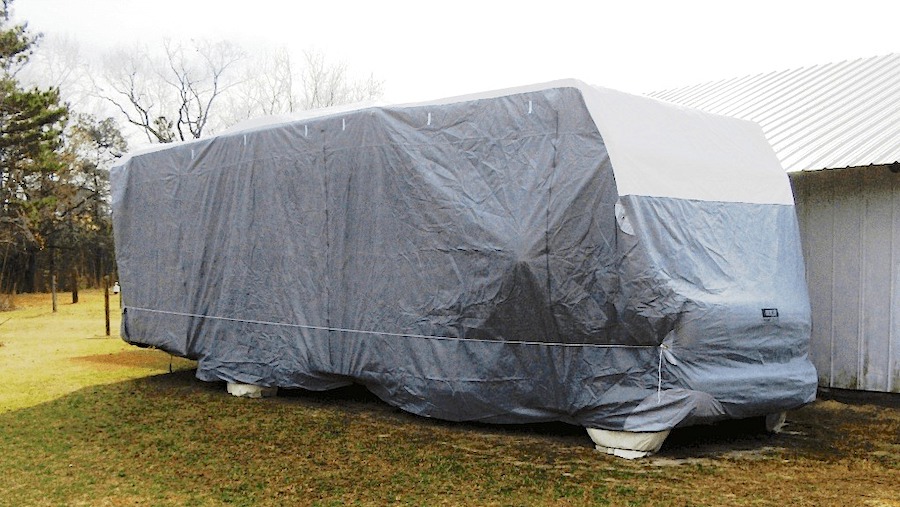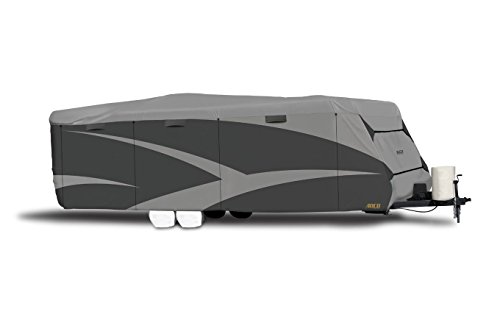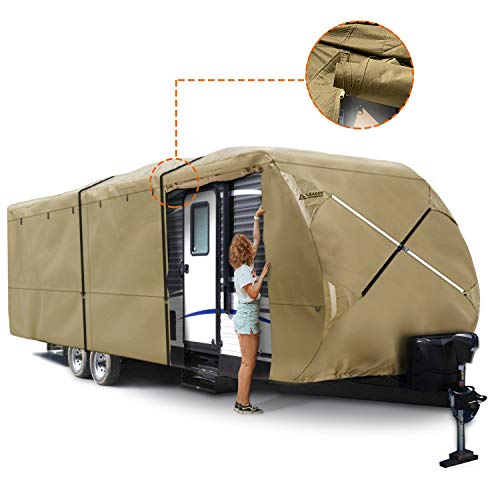Thanks for your support! If you make a purchase using our links in this article, we may make a commission. And, as an Amazon Associate, I earn from qualifying purchases. See the full disclosure here.
Updated February 18, 2024
When we don’t always have as much time to hit the road as we’d like, our RVs do a fair amount of sitting. That means that our RVs may be exposed to prolonged periods of sun and various weather conditions.
But, there’s a very simple and effective way to protect your rig – an RV cover!
How RV Covers Protect Your RV or Camper?
Rv covers protect against a number of harmful factors. For starters, if not covered properly, your vehicle’s exterior is subjected to UV degradation. This will damage the paint and fade the color of your rig.
This doesn’t just affect the exterior appearance of your RV, however, the paint actually acts as a protective exterior layer. With damaged paint, the sun can do further harm to the RV’s hull.
Most RV covers are waterproof, yet able to breathe. But, not all RV covers offer the same protection which is why prices may differ. However, all of them will help you keep your rig clean by protecting against dust, leaves, bird droppings, as well as rain and storms.
Types of RV Covers
There are several different types of RV covers and according to a number of criteria, there are a couple of important factors to consider before purchasing one.
Type of Rig
Basically, there are two broad categories of RVs: motorized and towable. Motorized RVs, better known as motorhomes, are basically small houses with engines and wheels. This means that you needn’t worry about (un)hitching the rig at camps. Class A, Class B, Class C motorhomes, as well as campervans, belong to this category. However, they are very different from one another; therefore, you need to study them well prior to buying the vehicle.
Towable RVs, also known as campers, don’t have an engine built-in, so they car or a truck to get around. The lack of a motor makes them affordable. There are five types of towable RVs: truck campers, fifth-wheel trailers, sport-utility trailers (toy haulers), travel trailers, and pop-up campers.
Material
In general, RV covers are made from polypropylene, polyethylene, or polyester.
Polypropylene RV covers work well in warm weather, but they are uniquely designed to function best in colder environments. These covers are less likely to crack and are highly resistant to acid damage and water while still being breathable. However, they are not waterproof.
Polyethylene is another common type of material used in the making of RV covers. It’s a strong fabric made of several layers of yarn fibers and is both water and tear-resistant. Polyester offers unmatched protection against UV rays. A polyester RV cover is made up of several layers of fibers or yarns.
It’s also not unlikely to come across solution-dyed acrylic covers. Made of UV-resistant dyes that offer superb sun protection and waterproof coating, making them resistant to most weather conditions.
Moving on, most of the high-end RV covers have double or triple layers to ensure durability and added protection. More layers imply a higher price tag, so it’s up to you to decide if you can handle the extra cost.
What Size RV Cover Do I Need?
When you are shopping for RV covers, the first thing you need to do is measure your rig. Length, width, and height are all important numbers. You will use this information to find the proper-sized cover for your RV.
Most RV covers come in generalized sizes. For example, you frequently will find that covers will be made to fit RVs in a range of lengths. If you have a 23-foot RV, the best option may be a cover that fits RVs between 20 and 24 feet long.
If you measure properly, the generalized size range will be right for most RVs. It is important to ensure that you are not buying a cover that is too large. RV covers that are too big can cause problems for your RV as well.
In windy conditions, an overly large cover can rub on the exterior features of your RV. Damage to paint and exterior edges is inevitable when combined with a shifting tarp. Too much movement can also cause your RV cover to tear or fray.
On the other hand, an RV cover that is too small will be a pain to install and remove. It is also more likely to tear at the seams and on corners.
How Much Does an RV Cover Cost?
Covers for smaller trailers or campers may be as low as around $60. For anything more substantial in size, you’ll be looking at $200 or more.
Basically, covers within the $100-$400 price range offer basic protection from UV rays, dust, wind, and rain. Usually, these covers come with a storage bag too. On a negative note, these covers are easily damaged in harsh weather conditions.
In the price range of $200 and up you’ll find an abundance of RV covers that can withstand more damaging weather conditions. They have more upscale features that can protect your RV both inside and outside. Pricier RV covers also offer higher mold and rust protection, are generally more breathable, and are more durable.
For a higher price, you can opt for a semi-custom or custom fit cover. Expect to pay anything between $300 to $1200 (depending on the size of your vehicle) for custom covers as they are usually made with more layers of stronger materials.
✅ Pros of Using an RV Cover
There are a number of reasons why RV covers are essential. Here are some of the most significant pros of using one:
- Protects from UV damage
- Water protection and weather protection
- Keeps the vehicle clean
- Helps keep the resale value intact
- The RV will require less exterior maintenance
- Affordable way to keep your RV safe
⛔️ Cons of Using an RV Cover
These are some of the main complaints RVers have about using covers:
- Covering bigger RVs can be challenging
- Adds an extra chore
- Low-quality RV cover don’t offer much protection
- If covered with snow, RV covers are hard to remove
You can skip all the cons and jump right to the benefits of using an RV cover just by doing one simple thing – buying the right cover!
Do RV Covers Cause Mold?
Some RV owners complain that their RV cover caused mold. This may seem to be a good reason to skip investing in an RV cover. However, as with many maintenance complaints, there are frequent user errors behind problems.
The best way to prevent your RV cover from causing mold is to purchase a good-quality product. This isn’t necessarily the most expensive cover. Just make sure that you take time to read reviews and do some research before hitting the purchase button.
Buying a good quality product does not always translate well to the climate where your RV is stored. It is very important to invest in a cover made from a breathable material. If you will be storing your RV in a place with high humidity, breathability will be key.
If you are storing it in a humid climate, you will want a polypropylene or other breathable material. However, a breathable material is not necessarily going to be a fix-all for molding in humid environments.
For extra protection, make sure that your RV cover is not only breathable but that it also has vents. Vents allow air to draw out humidity and dry the material faster after precipitation events.
Should You Cover An RV With A Tarp?
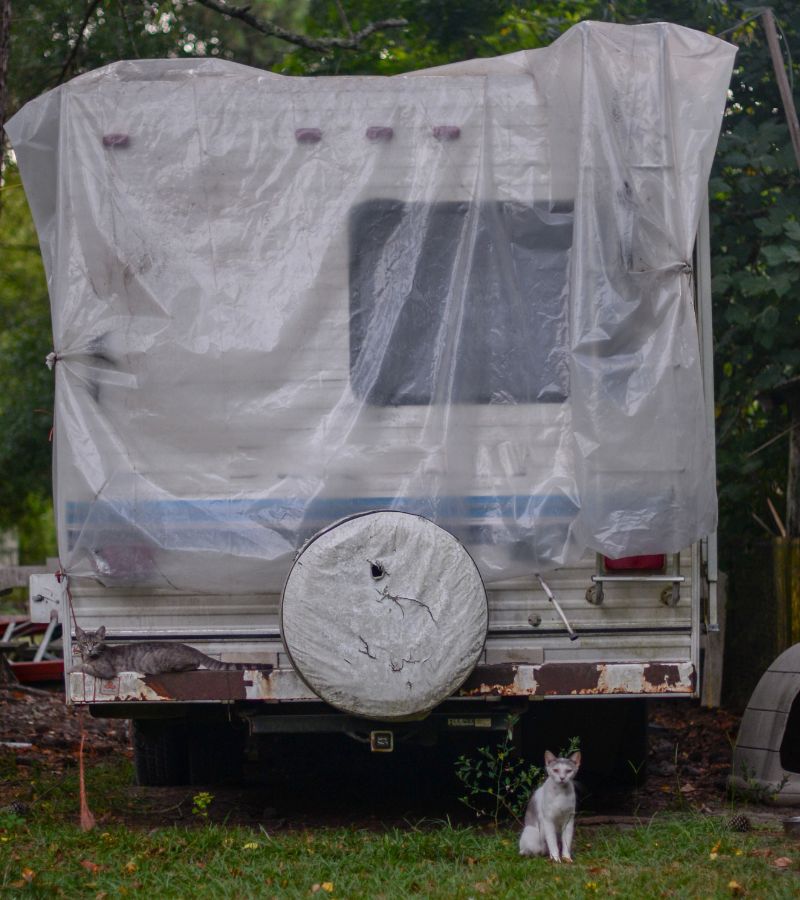
One thing you should never do is cover your RV with a tarp. Tarps are not breathable, and they are not made to protect the paint of your RV. They are fairly water resistant, but they are rough.
So, while you are protecting your RV from rain with a tarp, when the wind blows, the tarp will slowly rub away at your RV paint job. Damaging the paint finish of your RV can lead to other problems that you will not want to deal with.
If you have a roof leak or broken window, a tarp is a great temporary fix. However, as a permanent cover, it could cause more problems than it prevents.
How Do You Cover an RV?
Covering your RV isn’t a complicated process. Here are a few simple instructions:
- Place the cover on the roof of your RV
- Roll from the front end to the back end, side to side
- From the ground, pull the cover over the sides of the RV starting at the front and making your way backward
- Secure the hems under the front and rear of your RV
- Finally, use the die downs to secure it
Should I Cover the Tires Too?
Despite the fact that RVs come with heavy-duty tires, they still need some protection, especially when parked for long periods of time.
One of the main purposes of RV tire covers is to protect the tires from harmful sun elements and heat. Logically, as black or grey attract more heat, make sure you look for white covers.
Tire covers also offer protection from dry rotting, and they help your tires stay protected from cold weather. In addition, RV tire covers eliminate premature cracking on your RV tire sidewalls. Generally, RV tires should be replaced approximately every 7 years, or sooner. By keeping your tires covered, you may extend their life.
Tips for Storing Your RV Cover – It Won’t Go Back in the Box!
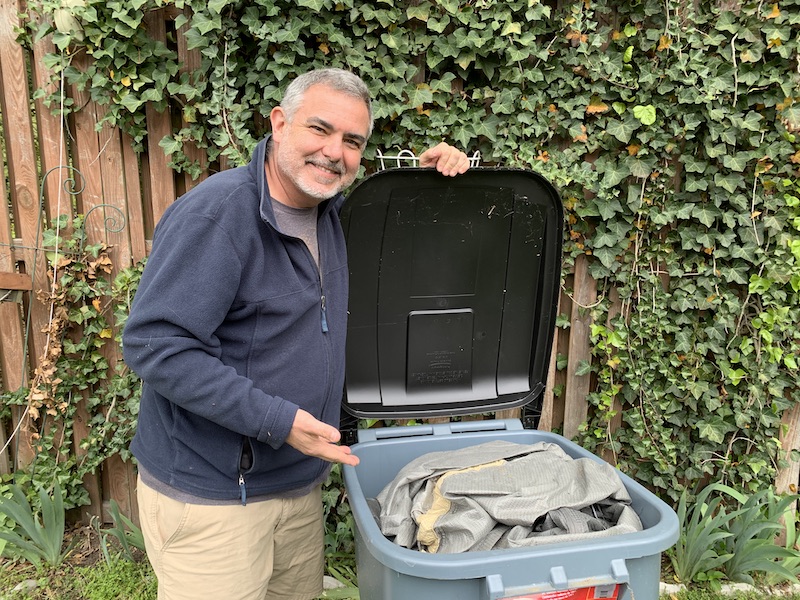
One of the most challenging things about RV covers is storing them properly. It can be really difficult to get it back into its container. We actually bought a large outdoor trash can with a tight lid and we keep our cover in there when not in use.
- Start by cleaning the cover before removing it from the vehicle and allow it to fully dry.
- Next, remove the cover by lifting it straight up to prevent it from catching on corners.
- After that, spread the RV cover out. Avoid getting wet during the process, it can lead to mold.
- Finally, proceed to fold the cover and you’re done. One great way to fold the RV cover is, to begin with folding lengthwise, reducing the width of the cover. Finish up by folding lengthwise and repeating the process as needed.
The Five Best RV Covers
Here are our top five picks for the best RV covers currently available for purchasing online:
1. Classic Accessories OverDrive PolyPro 3 Deluxe Travel Trailer Cover
This heavy-duty RV cover fits most RVs and campers on the market. The cover is available in various sizes ranging between 15 and 40 ft. in length.
The front and rear-end of the cover are adjustable via tension panels and elastic corners. The customized fit allowed by the cover is second to only much more expensive, luxurious, or custom-made covers. Not only does it look good, but it also cuts back on the amount of wind and rain that gets on your rig.
Even more, the RV cover is genuinely heavy-duty, triple-ply PolyPRO 3 materials, which keep out even the heaviest downpours of rain, sleet, and snow. This factor makes the cover an excellent selection for those who plan to store their RVs or campers somewhere that will be directly exposed to the harsh winter-elements (like their back-yards).
The cover also protects against light dings and scratches, such as falling branches from a tree during a storm. Furthermore, the cover provides an integrated rope system, built right in, and a toss bag (which supposedly actually works – according to many Amazon customers) for easy storing.
The cover has zipper panels as well. These allow for quick and easy access in otherwise hard-to-access areas (once your RV or camper is already covered) including engine compartments and doors. Additionally, the manufacturer provides a three-year warranty with the purchase of this RV cover.
2. ADCO Designer Series SFS Aqua Shed Travel Trailer RV Cover
ADCO’s Designer Series SFS Aqua Shed RV Covers are available in various sizes. You’ll be able to find them for most RVs and campers between 15 and 37 ft. in length.
The universal-fitting design of the cover is more than accommodating for even those bulkiest and odd-shaped areas of RVs, including AC units, ladders, and other mounts, toppers, slide-outs, and frontends.
These designer RV covers are made for protecting RVs and campers stored in regions with moderate to high-moisture climates. So, more or less, they should work just fine about anywhere (outside of the North Pole and Antarctica).
The ADCO Designer Series looks great on most RVs and campers, but, even more, it genuinely helps them retain their value and prevent aging and other unnecessary damage thanks to its triple-layered top panel and triple-layered sides.
3. Leader Accessories Travel Trailer RV Cover
This popular cover fits most RVs and campers that measure anywhere from 14 to 30 ft. long. They are available in multiple-covers such as beige, blue, grey, and green.
The covers consist of highly breathable material, triple-layered polypropylene fabric. Weather is no match for this RV cover, be it rain, snow, sleet, or even hail (excluding the ones the size of boulders – no cover will protect your rig from those bad boys, unfortunately, but your insurance may!).
For added safety, there are reflective safety panels built right into the fabric in just the right places to make you feel more comfortable having your rig covered while parking nearby traffic. It also includes built-in air vents which cut back on the amount of blowing-around that your cover does as well as keeping the moisture out and off of your RV or camper.
The corners of the cover are extra-reinforced by the manufacturer with elastic hems. This helps to give a custom fit to each rig as well as preventing tearing from covering odd-sized rigs. The material of the cover is also highly UV-resistant, so you don’t have to worry about leaving your RV or camper somewhere with no shade.
4. Wolf by Covercraft Travel Trailer RV Cover
The Wolf RV Cover by Covercraft is another really popular cover with the RVing community. You can find them in various sizes including everything from 15 to 31.6 ft. in length. In other words, they fit most trailers, RVs, and campers.
These RV covers are constructed of multi-layered polypropylene and are highly breathable in comparison to cheaper covers. They also come with straps and buckles built right in on the front and rear of the covers. This strap-and-buckle system allows for a much more secure fit for your RV or camper.
The covers also include rain cutter covers, so you don’t have to worry about possible damage from gutters. A patch kit for repairing damage does it somehow happen, is included as well. A storage bag that supposedly really works also comes with your purchase of the Wolf RV cover.
5. KING BIRD Deluxe Camper Travel Trailer Cover
KING BIRD’s Extra-Thick Deluxe RV Cover measures anywhere 18 to 36 ft. in length, depending on your selection of size. Not only are these covers extra-thick 4-ply, they include reinforced straps as well. For those seeking a heavy-duty RV cover, that isn’t going to blow off, this one is a great consideration for your list of potential covers.
The top of this cover is 4-ply and the sides are 3-ply, non-woven, making them more protective than normal RV covers. These covers make short-work of protecting campers and RVs from wind, rain, sleet, snow, and light hail. They also keep the UV-rays from doing any harm to your property as well.
The covers include six individual air vents built-in on both sides and do a great job of reducing blow-back or allow the wind to disturb its effectiveness and protect your RV from the elements. It’s also heavy-duty enough to protect your RV or camper from bumps, dings, and scratches.
The manufacturer included a two-year-warranty with the purchase of their cover. There’s also an easy-view window built-in to the cover for checking-in on your RV without having a big hassle. A four-piece wheel cover set and portable storage bag are also included with your purchase of this RV cover. It doesn’t get much better than that, for the price.
Final Thoughts About RV Covers
Our RVs give us all the freedom we need. The least we can do is to give our homes on wheels the right protection. That said, RV covers will do the trick!
Do you have a favorite cover for your RV or camper, or a helpful tip or trick for storing RV covers? If so, we’d love for you to share it with our audience in the comments section below!
Good luck finding the best RV cover for your rig!

